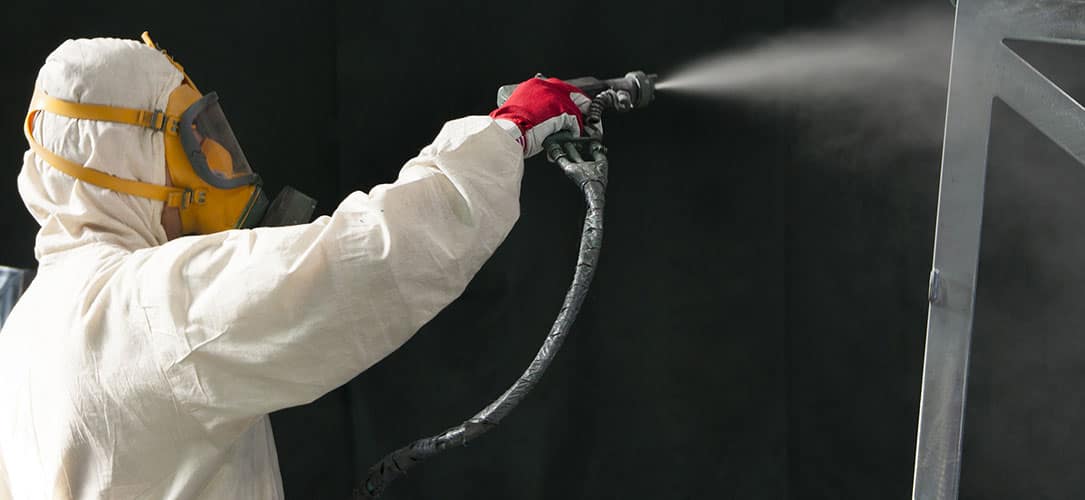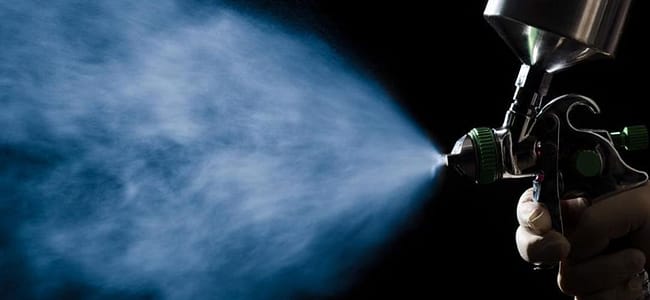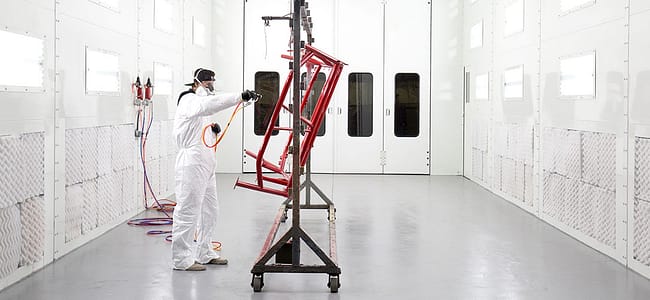
Even paint booths with the most advanced technology, best airflow and high-end features cannot protect a painter’s face and body from exposure to hazardous chemicals and fumes when spraying.
The use of personal protective equipment (PPE) is needed to keep painters safe on the job and help them avoid short- and long-term health risks. For PPE to be most effective, you must determine what PPE is appropriate for your operation and ensure you are using the right type.
Here are five of the most common questions about PPE for spray booths:
Paint fumes contain volatile organic compounds (VOCs) that can enter your system through inhalation or skin absorption. Short-term effects of exposure to VOCs include nausea, dizziness, headaches, shortness of breath and skin irritation. With repeated exposure to VOCs, symptoms can worsen, and more serious health issues may arise, most notably throat irritation, difficulty breathing and kidney damage. Prolonged VOC exposure can even cause chronic obstructive pulmonary disease (COPD), strokes and cancer.

According to OSHA, employees must have access to respirators to wear when spraying paint to protect their health. Respirators are recommended when the technician is working downstream of the object being sprayed.
To determine which level of PPE is necessary, check the safety data sheet (SDS) provided by your paint supplier. The SDS will identify the hazards that are present in the paint, in the “Health Hazard Data” section, as well as the recommended PPE to mitigate your risk, in the “Exposure Control/Personal Protection” section.
Your local authorities having jurisdiction (AHJ) — including OSHA inspectors, state workplace inspectors, health department officials, fire marshals or insurance company inspectors — may also specify what type of PPE is needed for your operation. PPE requirements often depend on the AHJ’s opinion and widely vary from city to city, county to county and state to state.
Air monitoring allows finishers to determine exposure levels inside a paint booth. If exposure levels exceed OSHA’s Permissible Exposure Limit (PEL) for the solvent being applied, a respirator must be worn.
In addition, air monitoring can serve as an indicator of the health of your paint booth. If the number of particles in the air is rising, you may have a problem with your booth’s filtering or air make-up system
When it comes to PPE, one size does not fit all. For example, painters with beards or prescription glasses may require different PPE. In addition to the PPE fitting comfortably, the person wearing the PPE must be able to properly perform their job, communicate effectively and not have their mobility limited.

If wearing a respirator when spraying paint, a fit test should be performed to ensure there is an adequate seal to your face. The respirator should fit snugly on your face, with no openings through which you could inhale VOCs.
Most paints and varnishes contain isocyanate compounds, a dangerous chemical that can irritate your skin or cause breathing issues when inhaled. A painter can become sensitized and allergic to the coatings they are spraying if their exposure to isocyanates reaches a certain level. This can result in breathing problems, asthma, hives and rashes, and if exposure is extreme, can even end a painter’s career.

To avoid exposure to isocyanates, technicians should wear a full-body paint suit when spraying. Nitrile gloves are recommended to protect against isocyanate sensitization. A full mask is also essential, and if the mask includes a fresh air supply, that can keep the painter cooler in the booth. When using a fresh air supply, a carbon monoxide meter should also be worn by the painter or installed in the fresh air system.
Rather than putting your health at risk, it is best to be overly cautious when selecting PPE for your paint operation. The consequences of cutting corners with PPE can be detrimental to your health and can potentially end your career as a painter. Use the SDS from your paint supplier to determine what PPE you need, then confirm that it meets the specifications of your local authorities.
One of the best ways to highlight your business is through a story that you can share across your online platforms. It humanizes your business and shows that your business can make a meaningful impact. Your testimonial would be used as a project profile on the GFS Booth Blog and can be shared on your website and/or social media channels.
Complete this form and we’ll be in touch to showcase your company.

Shop a variety of GFS aftermarket products, including booth protection products and mobile accelerated curing units. And enjoy the convenience of fast and free ground shipping throughout the contiguous United States.

Located at GFS’ headquarters in Osseo, Wisconsin, the Center for Excellence is an innovative facility featuring an automotive refinish training center, as well as a separate space dedicated to technical product training.

GFS is continuously searching for talented, ambitious individuals to join our team. We aim to provide our employees with every opportunity to make an impact on the company and find their niche along the way — weather in a production, field services or an office position.